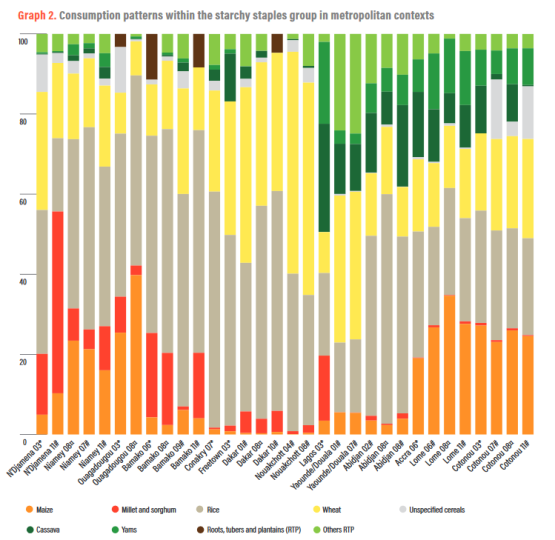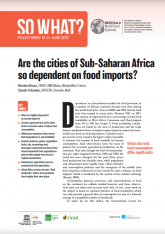Home > Publications > Policy Briefs > 4/ Are the cities of Sub-Saharan Africa so dependent on food (...)
– Cities are highly dependent on cereals imports.
– Cereals represent less of the third of the economic value of urban food consumption.
– Differences between cities reveal that dependence is not inevitable.
– Animal products, pulses, vegetables, fruits, oils, seasonings and beverages represent two third of the urban household food expenditures and provide largely from local or regional production.
– Subsistence agriculture turns to commercial food agriculture.
– Urban Africa creates its own “food modernity” where local products have largely their own place.
Dependence on international markets for food provision in a number of African countries became very clear during the world food price crises of 2008 and 2010 and the food riots that ensued in many cities. Between 1961 an 2011, the amount of imported food as a percentage of total food availability in West Africa, Cameroon and Chad jumped from 7% to 25% (see Graph 1). Food availability calcula-tions are based on the sum of production and the trade balance (understood here as imports minus exports), minus the measurable non-food use of food products. Calculated once per year for every country, the figure makes it possible to estimate the amount of food available for human consumption. Such observations form the basis of policies for increased agricultural production on the continent. That said, though the level of food produc-tion per capita stagnated between 1960 and 1980, the trend has since changed: for the past thirty years, food production has steadily risen, while population and urbanisation have rapidly risen. Urban lifestyles and consumption patterns, and the emergence of the middle class have long been understood as the reasons for such a reliance on food imports, which is facilitated by the system of free market exchange (Brunel, 2009).

Consumption patterns, practices, and representations of food on the continent are seldom studied however, and these observations have not taken into account such data. In fact, most work on the subject is based on national statistics of food availability, which can only provide a general idea of consumption by way of a national average of a simplified number of foodstuffs.
To make up for this deficit, the International Centre for Agricultural Research for Development (CIRAD) and the Economic and Statistical Observatory for Sub-Saharan Africa (AFRISTAT) have collaborated with Agence Française de Développement in an effort to better identify food consumption patterns. More specifically, the differences between urban and rural areas are identified and discussed.
Urban and rural food consumption differ significantly in terms of lifestyle and higher average income in cities. Both the number of urban dwellers in the total population, and levels of income are rising. As a result, national consumption trends can be regarded as tending to converge towards the template given by urban consumption trends.
Classifying food consumption according to the three categories of starchy staples, animal products and other products makes it possible to see that with urbanization comes diversification: while in rural areas, these categories make up approximately 49%, 22%, and 19% of total food consumption, in urban areas, the figures are much more balanced, with scores of 37%, 33%, and 30%, respectively. The difference in price elasticity of cereals in urban and rural contexts is thus easier to understand. In urban areas, if the price of cereals increases, people make up for it by using fewer animal products, vegetables, and/or oil in their sauces before changing their intake of cereals (Bricas, 1996).
The component of starchy staples in dietary consumption differs significantly from city to city in the region (see Graph 2).

In all cities, rice and wheat are the main staple food as these two cereals make up at least half of the total economic value of consumption of starchy products. Except in N’Djamena and Bamako, millet and sorghum represent only a small part of total urban consumption. In continental Sahelian countries, maize has become the preferred staple food, with roots and tubers as a variation. In coastal countries bordering the Gulf of Guinea, including Cameroon, roots, tubers, and maize have slightly less importance, and wheat slightly more, though overall consumption of the first three is still high.
Even though the large cities in the region under study are still heavily dependent on imports of rice and wheat, it cannot be said that local products have been marginalized in cities (Graph 2). Only millet and sorghum now have limited consumption rates, while maize, manioc, and yams are staples that are both frequently consumed and primarily produced locally. It is also the case, though at a lesser scale, for potatoes, taro, cocoyam, and plantain banana in certain cities in Cameroon, Ivory Coast and Senegal. In large cities on the coast in the Gulf of Guinea where tubers are a traditional staple food and where people still eat them often, the total consumption of rice and wheat amounts to less than half of the total consumption of starchy staples. Moreover, though rice has indeed become a choice staple in certain countries, it is partly produced in the regions themselves. Unfortunately, few studies differentiate between locally grown and imported rice. However, the studies that have been conducted in the capital cities of countries in the Western African Economic and Monetary Union (UEMOA), in the same year and with the same method, have included this distinction. As a result, it is possible to calculate a population-weighted average of starchy staples in the UEMOA: rice and wheat alone account for 72% of the economic value of cereals consumed, and 62% of the total of all starchy staples. The reliance of UEMOA cities on international food markets is clearly substantial. Taking a step back, however, cereals only make up one third of the total value of foods consumed, and imports therefore only amount to a limited 20% of total food expenditures for the region.
This general finding conceals major disparities however. In the case of Bamako, for example, rice and wheat contribute to less than a third of all starchy staples, with locally grown rice amounting to 40% of this consumption. In Lome and Cotonou, imported rice and wheat are only at 41% and 44% of all starchy staples—in fact, locally grown maize makes up more than one third of the total in Lome, and more than ne fourth of the total in Cotonou. Roots and tubers are also a major food group, representing one fifth of total starch consumption in the two cities. Such figures reveal that dependence on imported cereals in cities is not inevitable, and that both sahelian and coastal cities can rely on local food production to provide their requirements in terms of food staples.
Other types of products are indeed consumed more frequently in cities than in rural areas, but are nonetheless sourced locally in most cases, with the exception of dairy products, oils and sugar, in certain countries. Yet again, numerous examples prove that there is no fatality to resort to imports to feed the cities.
Similar conclusions can be drawn from comparison of urban consumption quintiles, and comparison of urban and rural areas with the same income. Lifestyle changes that accompany increases in income are correlated with diversification of food types, and with the consumption of products with high added value, animal products, and fruits. Such changes necessarily result in slight increases in the share of foods imported from industrialised countries; however, there is still a significant place left for local products, and for those that are processed within the region. Urban dwellers create new types of food by combining traditional ingredients with “modern” ones— for example, maize mawé and its derivatives in Cotonou; babenda, which is a mix of leaves and flour, and millet dégué in Ouagadougou; miondo, or cassava bibolo, in cities in southern Cameroon; plantain aloko in coastal cities; or cassava attiéké in Abdijan. Then there are foreign foods, such as bread or crispy fried rolls, or certain iconic urban foods that originate from a mix of regional practices, such as thiébou diène (rice with fish and vegetables) from Dakar, yam amala from Lagos, cassava garba from Abidjan, and the like. Each of these dishes has spread widely throughout the region.
Cities are largely fed on imported cereals such as rice and wheat, even if some countries still provide for their own needs with starchy staples such as maize, rice, cassava, and yams. Despite the amount of attention they garner, such products only account for one third of total food expenditures. Animal products, oils, fruits and vegetables, seasonings and beverages have become an important outlet for local agriculture and a variety of microenterprises and small agrifood business now add value to local produce. Previous colonial distinctions between export-oriented agriculture centred on cash crops and subsistence agriculture for self-sufficiency purposes no longer describe local realities. Food cultivation has indeed become market-oriented, aiming to sell not only to urban populations but rural ones as well. As Fernand Braudel notes regarding the economic history from the fifteenth to the eighteenth century, “As a rule, a measure of expansion in foreign trade preceded the laborious unification of the domestic market.” In the effort to conquer such markets—an effort that is still in the making—(Western) Africa is undergoing a form of food modernity, which is both similar and different from what is happening on other continents. Numerous examples can be found to illustrate how these new traditions draw upon local production and resources.
Data for this study derives from thirty-six national and municipal studies on household consumption (NHCS) in countries in West Africa, Cameroon, and Chad, conducted between 2001 and 2011 on a total of 230,000 households. Databases were constructed either by the national institutes of statistics (NIS) in each country, or by the World Bank. A significant amount of work was carried out in order to standardize the classification of foods consumed, and to enable their identification as having been locally produced or imported.
As not all of the individual studies were conducted in the same year, with the same objectives, or with the same methods of data collection and analysis, exact matching is difficult, especially between two given years in the same country. Yet the side-by-side comparison of the study results allows us to create an overall impression of food consumption and the differences related to urbanisation and economic life. Household consumption is understood to encompass self-sufficient production, non-market gifts and exchanges, and bought goods. The definition of urban space is relative to each country and has not been standardized [1].
– Nicolas Bricas, CIRAD, UMR Moisa, Montpellier, France
– Claude Tchamda, AFRISTAT, Bamako, Mali
Bricas N., 1996. L’effet de la crise sur l’alimentation des populations urbaines en Afrique. In Coussy J. et Vallin J. (Eds.), Crise et population en Afrique, Paris, Ceped, Coll. Les études du Ceped, n° 13, pp. 183-207.
Brunel S., 2009. Nourrir le monde, vaincre la faim. Paris, Larousse, 285 p.
This policy brief is based on some of the results of the book: Bricas N., Tchamda C., Mouton F. (dir.), 2017. L’Afrique à la conquête de son marché alimentaire intérieur. Enseignements de dix ans d’enquêtes auprès des ménages d’Afrique de l’Ouest, du Cameroun et du Tchad. 8 Paris, AFD, collection « Études de l’AFD », n° 12, 132 p. (forthcoming in English)
[1] This study was funded and conducted in partnership with the Agence Française de Develop-pement (AFD) and received complementary funding from the African Development Bank and
the European Commission under the program FP7/2007–2011 n°290693 FOODSECURE. It was completed in cooperation with the national institutes of statistics in Benin, Cameroon, Chad, Ivory Coast, Mali, Mauritania, Niger, Senegal, and Togo. The authors want to thank all the experts of these institutes who were involved in the study and Florence Mouton and Marie-Cécile Thirion from AFD for their important support.
